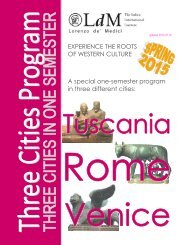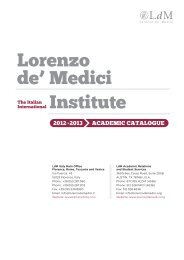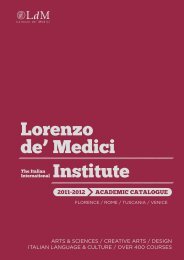aCademiC Catalog 2013-2014 - Lorenzo de Medici
aCademiC Catalog 2013-2014 - Lorenzo de Medici
aCademiC Catalog 2013-2014 - Lorenzo de Medici
Create successful ePaper yourself
Turn your PDF publications into a flip-book with our unique Google optimized e-Paper software.
School of Creative Arts FLORENCE<br />
attention will be <strong>de</strong>dicated to the relationship of the figure<br />
to the surrounding space (figure/ground relationships), and<br />
other projects will suggest unusual points-of-view, such as<br />
a particularly foreshortened form, focus, and <strong>de</strong>tail. The<br />
technique of tratteggio will be emphasized for shading in or<strong>de</strong>r<br />
to obtain the effect of chiaroscuro found in historical drawings.<br />
Evaluation will focus on specific drawing techniques found in<br />
the Renaissance with technical and stylistic consi<strong>de</strong>rations, and<br />
a portfolio of anatomical drawings and portions of copies done<br />
with tratteggio. Homework to improve manual <strong>de</strong>xterity and<br />
exploration of technical ability is required.<br />
Archaeology Workshop<br />
RES 193 F; Dual listed: CLA 193 F / ANT 193 F<br />
Cr: 3; Contact hrs: 45<br />
This course combines an introduction to archaeology with<br />
hands-on work on 2500 year-old archaeological finds in LdM’s<br />
Archaeology Lab. These finds have recently been unearthed<br />
in central Italy in the archaic settlement of Accesa, un<strong>de</strong>r the<br />
scientific direction of the University of Florence, and in the<br />
Hellenistic necropolis of Bosco <strong>de</strong>lla Riserva, near Tuscania,<br />
where an excavation project is being conducted by LdM<br />
Stu<strong>de</strong>nts will learn what happens to the finds once they leave<br />
their recovery contexts and arrive in Florence: here, un<strong>de</strong>r the<br />
expert guidance of the instructors, stu<strong>de</strong>nts will be involved<br />
in the fundamental activities of restoration, conservation,<br />
documentation,study and storage of the finds. This course<br />
will also give stu<strong>de</strong>nts a general survey of the evolution of<br />
the discipline of archaeology over time and it will introduce<br />
them to the ancient Etruscan civilization, which forms such an<br />
important part of Italy’s culture and heritage. Stu<strong>de</strong>nts will also<br />
have the opportunity to sign up to the summer workshop in<br />
Tuscania which operates directly at one of the archaeological<br />
sites.<br />
Florence and Southern Italy Restoration<br />
Workshop (Summer only)<br />
RES 225 F<br />
Cr: 6; Contact hrs: 90<br />
The course comprises three weeks in Florence and a field week<br />
in southern Italy. Stu<strong>de</strong>nts gain knowledge and practical skills<br />
concerning historical painting and restoration techniques,<br />
working with original polychrome woo<strong>de</strong>n sculptures and<br />
mural paintings. In Florence participants learn the original<br />
fresco techniques, from the mixing of fresco mortar (intonaco)<br />
to its application on support, and the use of pigments. Each<br />
participant makes a sinopia (preliminary un<strong>de</strong>rdrawing for<br />
fresco) and completes a small fresco on a terracotta support.<br />
Restoration techniques are pursued, including the <strong>de</strong>tachment<br />
of the participant’s own fresco from its support, a wall painting<br />
conservation method. Participants work with original works of<br />
art from the 16th to 17th centuries as they learn how to use the<br />
principal mo<strong>de</strong>rn painting restoration techniques. The course<br />
surveys historical oil and tempera painting techniques, ai<strong>de</strong>d<br />
by museum visits, and stu<strong>de</strong>nts learn to recognize the century<br />
in which paintings were created. During the field workshop<br />
week stu<strong>de</strong>nts work in the main church of Rocca Imperiale near<br />
Cosenza in Calabria, southern Italy. This town near the Taranto<br />
Gulf, an important ancient Greek settlement and a notable<br />
archaeological area, is also famous for its medieval fortress.<br />
Stu<strong>de</strong>nts apply appropriate materials and conservation and<br />
restoration techniques to authentic works of art. Following<br />
diagnostic study of the artwork in or<strong>de</strong>r to un<strong>de</strong>rstand dating<br />
and conservation conditions, stu<strong>de</strong>nts concentrate on cleaning<br />
and consolidating the artwork. Next stu<strong>de</strong>nts learn to use<br />
different products for the restoration of the surface layers. As<br />
the last step stu<strong>de</strong>nts work on the pictorial layer and may do<br />
some painting.<br />
Florence and Chianti Restoration Workshop<br />
(Summer only)<br />
RES 226 F<br />
Cr: 6; Contact hrs: 90<br />
In this course, held partly in Florence and partly in the Chianti,<br />
participants gain knowledge and practical skills concerning<br />
historical painting and restoration techniques. During the<br />
three weeks in Florence participants learn the original fresco<br />
techniques, from the mixing of fresco mortar (intonaco), its<br />
application on support, to the use of pigments. Each participant<br />
makes a sinopia (preliminary un<strong>de</strong>rdrawing for fresco) and<br />
completes a small fresco on a terracotta support. Restoration<br />
techniques are pursued, in part through the <strong>de</strong>tachment of<br />
the participant’s own fresco from its support, a wall painting<br />
conservation method. Participants work with original works of<br />
art from the 16th to 17th centuries as they learn how to use<br />
the principal mo<strong>de</strong>rn painting restoration techniques to bring<br />
period paintings back to their original states. The course also<br />
briefly surveys the historical techniques used for making oil<br />
and tempera paintings, and stu<strong>de</strong>nts learn to recognize the<br />
century in which paintings were created. Museum visits help<br />
to explain techniques used in class. During the field workshop<br />
week participants will work in the town of San Gusmè in the<br />
Chianti region between Florence and Siena. Participants will<br />
ripristinate the original polychromatic surfaces of important<br />
16th-century altars in the principal church. They will remove<br />
the pigments of the preceding restoration of about a century<br />
ago, with scalpels, eliminating the chromatic distortion of this<br />
overpainting. Participants then proceed to reconstruct the<br />
work with colored stucco and tempera, with a final wax stratum<br />
to ren<strong>de</strong>r the beautiful original effect.<br />
Theory of Conservation<br />
RES 230 F<br />
Cr: 3; Contact hrs: 45<br />
This course will discuss the techniques used in paintings<br />
on panel and on canvas, fresco, and polychrome woo<strong>de</strong>n<br />
sculpture in or<strong>de</strong>r for the stu<strong>de</strong>nt to become acquainted with<br />
the actual historical materials and the conservation methods<br />
used on each of these. Practical <strong>de</strong>monstrations using real<br />
materials (pigments, glue, resin, plaster, canvas) will also help<br />
illustrate theoretical dimensions of this topic. Classes will also<br />
consi<strong>de</strong>r the ethics and issues encountered throughout the<br />
field of restoration and its history. These concepts will also be<br />
discussed during museum visits in Florence and will be used<br />
in class for discussion. Examination and discussion of a work<br />
of art are important elements before, during, and after every<br />
intervention. Lectures will examine various fresco techniques<br />
found throughout art history and specific examples of fresco<br />
restoration applied to these works. We will visit Santa Croce<br />
and the Brancacci Chapel to illustrate the technique and the<br />
restoration used on specific works. The restoration of paintings,<br />
both on panel and canvas, will be discussed using visual images<br />
and, most importantly, museum visits, for a better un<strong>de</strong>rstanding<br />
of techniques. For example a visit to the Bargello will highlight<br />
the collection of polychrome woo<strong>de</strong>n sculpture and the various<br />
restoration techniques found on this medium. The course will<br />
conclu<strong>de</strong> with the stu<strong>de</strong>nts’ own opinions on restoration as a<br />
profession and will examine the various responsibilities that<br />
an art conservator encounters when working with art history’s<br />
most precious documentation.<br />
Historical Painting Lab I<br />
RES 245 F<br />
Cr: 3; Contact hrs: 90<br />
The history of painting techniques used throughout the ages<br />
is an important part of the conservator’s role in recognizing<br />
how a work of art is ma<strong>de</strong> and what materials were used<br />
(fresco, tempera, oil, etc.). Stu<strong>de</strong>nts will make small panels<br />
using various samples so that they may become more familiar<br />
with techniques used for the paintings they restore. Cennino<br />
Cennini’s The Craftsman’s Handbook will be used as a textbook<br />
for these ancient procedures to be done from scratch: egg<br />
tempera, self-ma<strong>de</strong> oil paints, the gesso-colletta primer for<br />
canvas and panels, gold gilding, <strong>de</strong>corative arts, etc. Maximum<br />
care is to be put into these partial ‘copies’ in or<strong>de</strong>r for them to<br />
be part of the conservation stu<strong>de</strong>nt’s portfolio.<br />
Science for Conservators I<br />
RES 250 F<br />
Cr: 3; Contact hrs: 45<br />
This course will provi<strong>de</strong> conservation stu<strong>de</strong>nts with essential<br />
up-to-date tools for a more scientific approach to restoration<br />
practice. It will outline the basic concepts of chemistry in<br />
or<strong>de</strong>r to integrate a more in-<strong>de</strong>pth knowledge of the materials<br />
and techniques used in the profession. The course covers the<br />
general function of molecules, chemical bonding and chemical<br />
equations, with an introduction to the materials found more<br />
98<br />
LdM Aca<strong>de</strong>mic <strong>Catalog</strong> <strong>2013</strong>-<strong>2014</strong>





